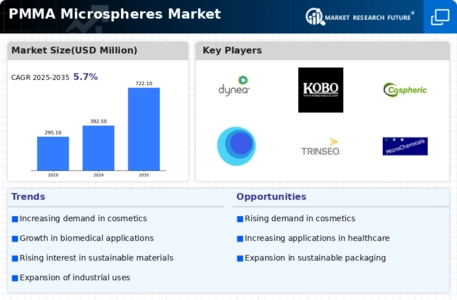Growth in the Healthcare Sector
The PMMA Microspheres Market is significantly influenced by the growth in the healthcare sector, particularly in drug delivery systems and diagnostic applications. PMMA microspheres are increasingly being employed in targeted drug delivery, where they serve as carriers for pharmaceuticals, enhancing the efficacy of treatments. The healthcare market is anticipated to witness a compound annual growth rate (CAGR) of around 7% over the next few years, which could further bolster the demand for PMMA microspheres. Additionally, their application in diagnostic imaging, such as in ultrasound contrast agents, is gaining traction. This trend suggests that the healthcare sector's expansion will likely propel the PMMA Microspheres Market, as the need for advanced medical solutions continues to rise.
Rising Demand for Lightweight Materials
The PMMA Microspheres Market is benefiting from the rising demand for lightweight materials across various applications. Industries such as automotive and aerospace are increasingly focusing on reducing weight to enhance fuel efficiency and performance. PMMA microspheres, known for their low density and high strength, are being integrated into composite materials to achieve these objectives. The automotive sector, for instance, is projected to grow at a CAGR of approximately 4% in the coming years, driven by the need for lightweight components. This trend indicates a growing preference for materials that contribute to sustainability and efficiency, thereby positioning PMMA microspheres as a favorable choice in the market. As industries continue to prioritize lightweight solutions, the PMMA Microspheres Market is likely to experience sustained growth.
Technological Innovations in Production
Technological innovations in the production of PMMA microspheres are playing a crucial role in shaping the PMMA Microspheres Market. Advances in manufacturing techniques, such as the development of more efficient polymerization processes, are enabling the production of microspheres with enhanced properties. These innovations not only improve the quality of the microspheres but also reduce production costs, making them more accessible to various industries. The introduction of automated systems and real-time monitoring technologies is further streamlining production processes. As a result, manufacturers are better equipped to meet the increasing demand for high-performance PMMA microspheres. This technological progress suggests that the PMMA Microspheres Market will continue to evolve, driven by the need for superior products and cost-effective solutions.
Environmental Regulations and Sustainability
The PMMA Microspheres Market is increasingly influenced by environmental regulations and the growing emphasis on sustainability. As industries face stricter regulations regarding waste management and environmental impact, there is a shift towards using eco-friendly materials. PMMA microspheres, being recyclable and less harmful to the environment, are gaining popularity as a sustainable alternative in various applications. The push for sustainable practices is evident in sectors such as construction and packaging, where the demand for environmentally friendly materials is on the rise. This trend is likely to drive the growth of the PMMA Microspheres Market, as companies seek to comply with regulations while also appealing to environmentally conscious consumers. The alignment of PMMA microspheres with sustainability goals positions them favorably in the market.
Increasing Applications in Various Industries
The PMMA Microspheres Market is experiencing a notable expansion due to the increasing applications of PMMA microspheres across diverse sectors. These microspheres are utilized in coatings, cosmetics, and biomedical applications, among others. For instance, in the coatings industry, PMMA microspheres enhance the durability and aesthetic appeal of products. The demand for high-performance coatings is projected to grow at a rate of approximately 5% annually, indicating a robust market potential. Furthermore, in the cosmetics sector, PMMA microspheres are favored for their lightweight and smooth texture, which contributes to the formulation of high-quality products. This versatility in application is likely to drive the growth of the PMMA Microspheres Market, as manufacturers seek innovative solutions to meet evolving consumer preferences.


















Leave a Comment